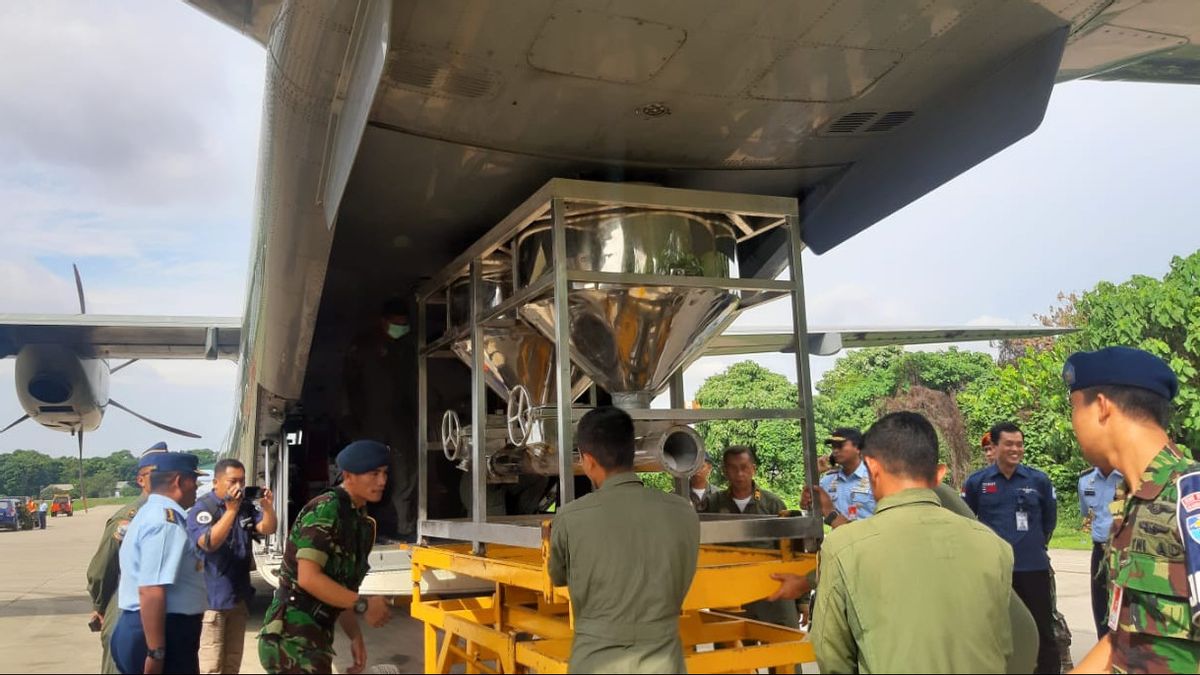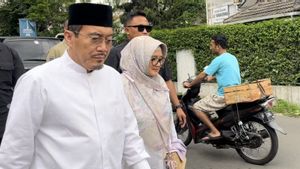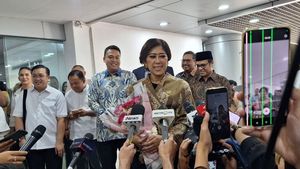JAKARTA - Jakarta and a number of its buffer areas have been flooded. The authorities move to control the rain with weather modification techniques. Yes, controlling the rain. Not a flood. Weather mods, however, are only shortcuts, only appearing as a way out. It's never really a solution. In fact, what is not really realizing is the bad impact that this shortcut could have.
Two days after the large-scale flood that submerged Jakarta, Tangerang and Bekasi, we flew with the Agency for the Assessment and Application of Technology (BPPT) to see first hand the weather modification process. We penetrate the cumulonimbus cloud to seed tens of tons of hygroscopic substances, such as table salt (NaCI) and CaCI2 onto the cloud seeds that reveal the potential for rain.
Gilang, the captain of the CN95 plane that transported us explained that the weather modification technique was carried out to stimulate rain before reaching the mainland of Jakarta, Bogor, Depok, Tangerang and Bekasi (Jabodetabek). To determine the seedling cloud is not arbitrary. The team uses the weather radar installed on the plane to detect seeds of clouds.

"We sowed as much as 2.4 tons of seed material consisting of eight consoles put on the plane. Then, carried out a flight to the Sunda Strait area and sowed the clouds around the Sunda Strait, the goal is to make the clouds rain immediately before arriving in the region. Jabodetabek. Thus, flooding will be avoided or minimizing the risk of flooding that will occur, "said Gilang, Friday, January 3.
"When conducting flights, the potential for clouds that we can see is using a weather radar installed on the plane. Then, if it is still during the day it can also be seen visually, we can do it visually. Can identify various types of clouds, which have the potential. for rain, like CB or cumulonimbus clouds, "he added.
BPPT is well aware that its steps are bearing fruit. Rain no longer falls on the mainland of Jakarta and its surroundings. Last Saturday, January 11, the Head of BPPT Hammam Riza stated that his party would be more intensive in applying weather modification techniques to prevent rain from falling in Jakarta. BPPT will fly two planes to carry supplies of salt for seedlings in four to five flight sorties.
"We will fly up to four to five flight sorties. This is an effort to reduce the potential for very high rainfall," he said in a press release.
Rain, what's wrong?
Authorities may clap the chest to prevent flooding. However, at the same time, it feels like the authority also needs to knock on the head, what is it that is trying to negate? Rain or flood? With weather modification techniques, it seems we can ask: what's wrong with rain?
This matter needs to be really thought about. Therefore, weather modification is not without risks. Environmental expert, Tarsoen Waryono, said that weather modification techniques have the potential to disrupt groundwater supplies. He explained that weather modification has the potential to encourage acid rain to fall, which can disrupt the hydrological cycle.
The hydrological cycle is a continuous circulation of water, moving from the atmosphere to the earth and back again into the atmosphere. According to Tarsoen, improper weather modification will destroy the cycle because humans are forced to use groundwater to meet human needs. Meanwhile, the rain, which enriches the water in the ground, never falls.

"If this is done continuously, the system will be damaged. Ground water is sucked in for the benefit of humans, but it is not balanced with rainwater," said Tarsoen, written by CNNIndonesia.com, Monday, January 13.
Apart from that, rain, however, must be interpreted as a blessing. The proof is that heavy rain, which was the cause of the floods on January 1, at the same time cleared the air of Jakarta, which was surrounded by pollution for months. The day the floods hit, a netizen shared the results of monitoring the air quality in Jakarta on July 26, 2019 and January 1, 2020.
As a result, the Air Quality Index (AQI) in July showed the number reached 184, which means it is not healthy. Different results appear in the air quality test dated January 1. In the images that are shared, Jakarta's air quality shows the number 24 AQI. This means that Jakarta's air is very good when it rains. Unfortunately, the land is not ready to accept the rain's blessing.
from this to this pic.twitter.com/BismSambH5
- Zafira (@firawayf) December 31, 2019
Solution?
The government, at the central and regional levels, are trying to cooperate in dealing with floods in Jakarta. Unfortunately, the cooperation is not very good. The Central Government wants the continuation of the construction of two dams in Sukamahi and Ciawi. This dam is considered to realize flood management from upstream to downstream.
"The President directs that it should continue. So in handling floods in Jakarta in the upstream part, we will build two dams, namely the Sukamahi Dam and the Ciawi Dam. We will finish all of them in 2020," said Minister of Public Works and Public Housing (PUPR) Basuki Hadimuljono. Wartaekonomi.com, Friday, January 5.
According to Basuki, the progress of land acquisition for dams has reached 95 percent. Next, it remains only to carry out physical development. In addition to the construction of dams in the upstream area, the government will also continue a number of development programs in the downstream area, one of which is the normalization of the Ciliwung River.
There's a matter here. Jokowi's will is not in harmony with the plan of the DKI Jakarta Provincial Government (Pemprov), which is said to have opted for naturalization. Not solving the flood, the two parties were even trapped in a debate about the term. Anies said, there is not much difference between normalization and naturalization. Both of them carry the concept of widening the river body.
The difference is that normalization is concrete concrete of river bodies, while naturalization is to restore the absorption area around the river body by providing land and trees along the river body. Another similarity, both of them are both a master plan for flood prevention in the capital city.

From Yogyakarta, the voices of the Gadjah Mada University (UGM) professors were playing to break the debate over authority in Jakarta. From hydrologists, there are Rachmad Jayadi and Budi Santoso Wignyosukarto. Representing hydrology and coastal engineering experts, Nur Yuwono and Bambang Triatmodjo attended. Apart from that, the river conservation activist, Suratman, and the Chairperson of the UGM Center for Environmental Studies, Mohammad Pramono also spoke out.
All agree that the solution to handling Jakarta's floods must be done by first observing the extraordinary massive development of Jakarta. "We must see that the development in Jakarta is extraordinary. Meanwhile, it is difficult to increase drainage capacity in urban areas. So what can be done? The community and government must start something," said Rachmad, written by Liputan6.com, January 7.
The first is rainfall recharging. In Jakarta, the construction of a building must be accompanied by an obligation to construct an infiltration well. This requirement must be included in the building construction permit (IMB). Second, control through environmental impact analysis (AMDAL). In other words, every major area development plan must go through a calculation of the potential risk of flooding.
Next, normalization. Referring to hydraulic terms, normalization can be interpreted as restoring the function of the river as a source of life. When referring to Anies's term, normalization makes more sense than naturalization by considering social, economic and environmental aspects. Naturalization is good in concept.
However, there are consequences behind it. The water rate in the naturalization concept is slower than normalization. In fact, accelerating the rate of water is one thing that is needed to reduce the impact of flooding in Jakarta. "The solution now is that the water is fast, the space is narrow, it has to be artificial, given a slippery wall so that the water flows faster and is resistant to erosion," said Rachmad.
Regarding rain as the cause of flooding, Jakarta must optimize its internal drainage function so that water can be evacuated properly. The drainage system must be accurate, especially regarding water management. Where the water will be diverted when it rains.
The English, Chinese, Japanese, Arabic, and French versions are automatically generated by the AI. So there may still be inaccuracies in translating, please always see Indonesian as our main language. (system supported by DigitalSiber.id)









